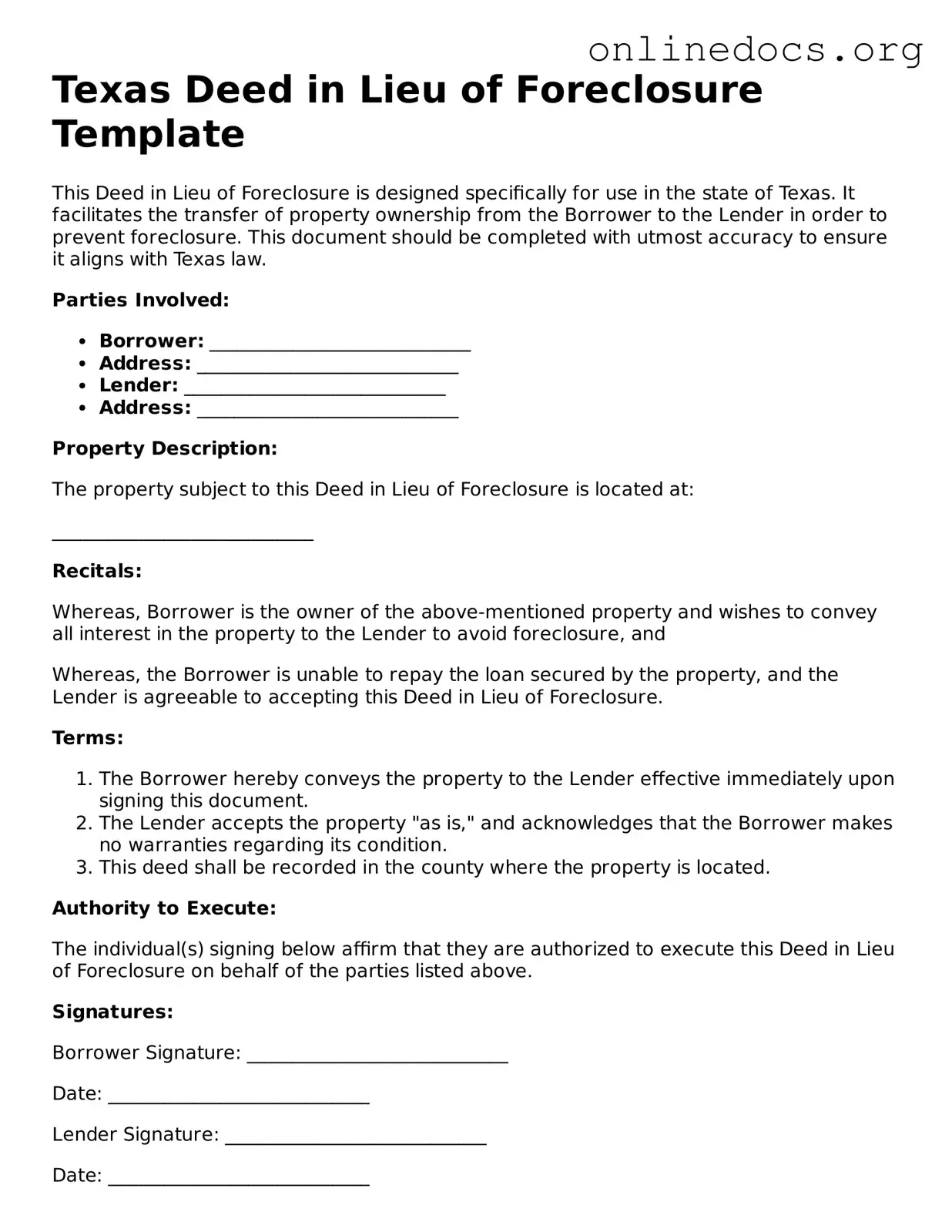The Texas Deed in Lieu of Foreclosure is similar to a mortgage release. Both documents serve to release the borrower from their obligations under the mortgage. In a mortgage release, the lender agrees to cancel the mortgage lien on the property, usually after the borrower has paid off the loan. In contrast, the Deed in Lieu transfers ownership of the property back to the lender, allowing for a smoother resolution to the foreclosure process. Both documents aim to relieve the borrower from further liability, but they do so in different ways.
Another document comparable to the Deed in Lieu of Foreclosure is a short sale agreement. A short sale occurs when a homeowner sells their property for less than the amount owed on the mortgage, with the lender's approval. Like the Deed in Lieu, a short sale helps the borrower avoid foreclosure. However, in a short sale, the borrower remains responsible for any remaining debt after the sale unless the lender forgives it. Both options provide alternatives to foreclosure, but they involve different processes and outcomes for the borrower.
A foreclosure settlement agreement is also similar to the Deed in Lieu of Foreclosure. This document outlines the terms under which a borrower can settle their mortgage debt without going through the entire foreclosure process. Both documents aim to provide a solution for borrowers struggling to keep their homes. However, a foreclosure settlement agreement typically involves negotiated terms that may include a payment plan, while a Deed in Lieu transfers ownership of the property directly to the lender.
The loan modification agreement shares similarities with the Deed in Lieu of Foreclosure as well. In a loan modification, the lender agrees to change the terms of the existing mortgage to make it more manageable for the borrower. This could involve reducing the interest rate or extending the loan term. Both documents provide relief for borrowers facing financial difficulties, but a loan modification keeps the borrower in their home, whereas a Deed in Lieu relinquishes ownership.
A quitclaim deed is another document that bears resemblance to the Deed in Lieu of Foreclosure. A quitclaim deed allows a property owner to transfer their interest in the property to another party without any warranties. While a quitclaim deed does not specifically address mortgage obligations, it can be used in situations where a borrower wants to relinquish their interest in a property, similar to how a Deed in Lieu transfers ownership to the lender. Both documents facilitate the transfer of property rights, but they serve different purposes in the context of debt resolution.
In navigating the complexities of real estate issues, understanding necessary documents such as the Deed in Lieu of Foreclosure is essential. Additionally, for landlords faced with challenging tenant situations, utilizing a California Notice to Quit form is crucial. This legal form, which can be found at https://californiapdfforms.com/notice-to-quit-form, serves as a formal means to request that tenants vacate their rental properties, ensuring clarity and compliance with legal expectations.
Additionally, a bankruptcy filing can be compared to the Deed in Lieu of Foreclosure. When a borrower files for bankruptcy, they may seek to discharge their debts, including mortgage obligations. This can lead to a foreclosure process, but a Deed in Lieu allows the borrower to avoid the lengthy bankruptcy proceedings. Both options provide a way out for borrowers facing financial hardship, yet they involve different legal processes and implications for the borrower's credit and future financial situation.
Lastly, a property settlement agreement can also be likened to the Deed in Lieu of Foreclosure. This document is often used in divorce proceedings to divide assets, including real estate. When a couple decides to sell their home as part of the settlement, they may opt for a Deed in Lieu to simplify the transfer of ownership back to the lender. Both documents facilitate the transfer of property, but a property settlement agreement focuses on asset division, while a Deed in Lieu addresses mortgage obligations and foreclosure avoidance.
